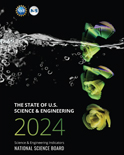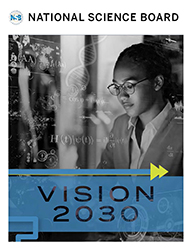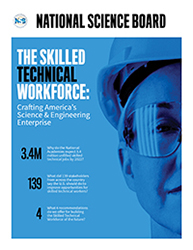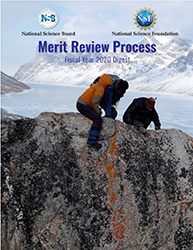News Release 16-006

U.S. science and technology leadership increasingly challenged by advances in Asia
China is now decisively the second-largest performer of research and development
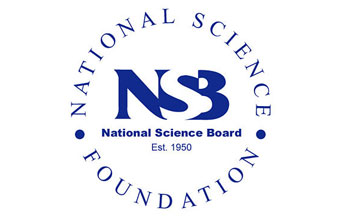
Indicators documents trends that affect the U.S. science and engineering enterprise (Credit and Larger Version)
January 19, 2016
According to the latest federal data, the U.S. science and engineering (S&E) enterprise still leads the world. The United States invests the most in research and development (R&D), produces the most advanced degrees in science and engineering and high-impact scientific publications, and remains the largest provider of information, financial, and business services. However, Southeast, South, and East Asia continue to rapidly ascend in many aspects of S&E. The region now accounts for 40 percent of global R&D, with China as the stand-out as it continues to strengthen its global S&E capacity.
These and other data on the domestic and global S&E landscape can be found in the National Science Board's (NSB) Science and Engineering Indicators 2016 (Indicators) report, released today.
"Indicators is a rich source of information on a wide range of measures that let us know how the United States is performing in science and technology," said NSF Director France Córdova. "It gives us crucial information on how we compare to other nations in the areas of research and development, STEM education, and the development of our workforce. The report also provides state-level comparisons, insights into the representation of women and minorities in science and engineering, and insight into what the public thinks about science."
China dominates Asian advances
The 2016 edition of Indicators highlights that China, South Korea and India are investing heavily in R&D and in developing a well-educated workforce skilled in science and engineering. Indicators 2016 makes it clear that while the United States continues to lead in a variety of metrics, it exists in an increasingly multi-polar world for S&E that revolves around the creation and use of knowledge and technology.
According to Indicators 2016, China is now the second-largest performer of R&D, accounting for 20 percent of global R&D as compared to the United States, which accounts for 27 percent.
Between 2003 and 2013, China ramped up its R&D investments at an average of 19.5 percent annually, greatly exceeding that of the U.S. China made its increases despite the Great Recession. Developing economies that start at a lower base tend to grow much more rapidly than those that are already functioning at a high level; nonetheless, China's growth rate in this arena has been remarkable.
China is also playing an increasingly prominent role in knowledge and technology-intensive industries, including high-tech manufacturing and knowledge-intensive services. These industries account for 29 percent of global Gross Domestic Product (GDP) and for nearly 40 percent of U.S. GDP. China ranks second in high-tech manufacturing, where the U.S. maintains a slim lead with a global share of 29 percent to China's 27 percent. While China plays a smaller role in commercial knowledge-intensive services (business, financial, and information), it has now surpassed Japan to move into third place behind the United States and the European Union.
China has also made significant strides in S&E education, which is critical to supporting R&D as well as knowledge and technology-intensive industries. China is the world's number-one producer of undergraduates with degrees in science and engineering. These fields account for 49 percent of all bachelor's degrees awarded in China, compared to 33 percent of all bachelor's degrees the U.S. awards.
In 2012, students in China earned about 23 percent of the world's 6 million first university degrees in S&E. Students in the European Union earned about 12 percent and those in the U.S. accounted for about 9 percent of these degrees.
University degree production in China has grown faster than in major developed nations and regions, rising more than 300 percent between 2000 and 2012; during the same period, the number of non-S&E degrees conferred in China also rose by 1,000 percent, suggesting that China is building capacity in all areas, not just S&E. The number of S&E graduate degrees awarded in China is also increasing. However, the U.S. continues to award the largest number of S&E doctorates and remains the destination of choice for internationally mobile students.
"Other countries see how U.S. investments in R&D and higher education have paid off for our country and are working intensively to build their own scientific capabilities. They understand that scientific discovery and human capital fuel knowledge- and technology-intensive industries and a nation's economic health," said Dan Arvizu, NSB chair.
Federal commitment wavering
At the same time that China and South Korea have continued to increase their R&D investments, the United States' longstanding commitment to federal government-funded R&D is wavering. In 2013, government funded R&D accounted for 27 percent of total U.S. R&D and was the largest supporter (47 percent) of all U.S. basic research.
Indicators shows that Federal investment in both academic and business sector R&D has declined in recent years, reflecting the effects of the end of the investments of ARRA (American Recovery and Reinvestment Act), the advent of the Budget Control Act, and increased pressure on the discretionary portion of the federal budget. Since the Great Recession, substantial, real R&D growth annually -- ahead of the pace of U.S. GDP -- has not returned. Inflation-adjusted growth in total U.S. R&D averaged only 0.8 percent annually over the 2008-13 period, behind the 1.2 percent annual average for U.S. GDP.
"Decreased federal investment is negatively impacting our nation's research universities," said Kelvin Droegemeier, NSB vice chair and vice president for research at the University of Oklahoma. "Our universities conduct 51 percent of the nation's basic research and train the next generation of STEM-capable workers. Federal support is essential to developing the new knowledge and human capital that allows the U.S. to innovate and be at the forefront of S&T."
Americans support science
Despite ongoing challenges with federal investment in R&D, Americans have generally favorable views toward science, believing that science creates more opportunity for the next generation, that its benefits outweigh its risks, and that the federal government should provide funds for scientific research.
Additionally, despite declining public confidence in most U.S. institutions, Americans' confidence in the scientific community remains strong. However, Americans take a dim view of our nation's performance in K-12 science, technology, engineering, and mathematics (STEM) education; most believe other countries are doing a better job. About half of Americans worry that science is making life "change too fast," up from about one-third who expressed this concern a decade ago.
Americans remain divided on global warming, an issue that science informs but which cultural and other factors also heavily influence. However, a majority of Americans say they would prefer a focus on alternative energy sources over fossil fuel development. Eight out of ten say they would like to see more emphasis on fuel efficiency standards for vehicles and renewable energy development.
"Our country's commitment to investing in R&D and in our higher education institutions has and continues to fuel our success," said NSB chair Arvizu. "Other countries are emulating our model. We can view these advancements as opportunities for our global society to tackle complex problems, such as energy demands, food and water security, and disease. At the same time, we need to remain steadfast in our nation's dedication to that which has served us so well: investing in people and their ideas."
About Indicators
Science and Engineering Indicators is the most comprehensive source of high-quality federal data on a wide range of topics that include trends in global R&D investments and knowledge-intensive production, K-12 and postsecondary STEM education, workforce trends and composition, state level comparisons, and public attitudes and understanding of science and related issues. Other, related resources include the Indicators Digest, state data tool, STEM education interactive online resource, and NSB's 2015 report, Revisiting the STEM Workforce.
About NSB
The NSB is the policymaking body for the National Science Foundation. NSB also advises the President and Congress on science and engineering policy issues. The Board's 24 members are drawn primarily from universities and industry and represent a variety of science and engineering disciplines. Selected for their eminence in research, education or public service and records of distinguished service, Board members serve six-year terms. NSF's Director is an ex officio 25th member of the Board.
-NSF-
Useful NSB Web Sites:
Home Page: http://www.nsf.gov/nsb
Media Contact: http://www.nsf.gov/staff/staff_bio.jsp?lan=nlymn&org=NSF
News: http://www.nsf.gov/nsb/news
Meetings: http://www.nsf.gov/nsb/meetings
Publications: http://www.nsf.gov/nsb/publications
Facebook: https://www.facebook.com/NationalScienceBoard
Twitter: Twitter: https://twitter.com/intent/user?screen_name=NSF_NSB
YouTube: https://www.youtube.com/channel/UCkrHRzuGSrPp2haQs0T_Pww
To view PDF documents, please download Adobe Acrobat Reader.
